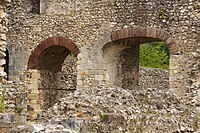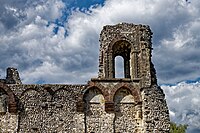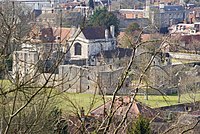Wolvesey Castle
Early history
The site is an eyot in the River Itchen known as Wulveseye or Wulf's island. There were buildings there during the Roman period. The building before Wolvesey Castle was constructed around 970 by Æthelwold of Winchester, the Bishop of Winchester from 963 to 984, as his official residence or palace.
William Giffard
About 1110, the second Norman bishop, William Giffard, constructed a new hall to the south west.
Henry of Blois
Giffard's successor, Henry of Blois, brother of King Stephen added a second hall to the west between 1135 and 1138.
Winchester came under siege during the Rout of Winchester in 1141 by the Empress Matilda during the period of civil war known as The Anarchy, and held out for three weeks until relieved by Stephen's wife, Matilda. Subsequently Henry, the brother of Stephen, King of England, enlarged and fortified the palace by building a curtain wall, giving the palace the appearance of a castle.
Later history
In June 1216, Oliver fitz Regis defended the buildings when they were besieged by Prince Louis of France during the First Barons' War.
The palace was the location of the wedding breakfast in 1554 of Queen Mary and Philip II of Spain. It was destroyed by the Roundheads during the English Civil War in 1646. The ruins are located next to the existing bishop's palace, and are currently owned and maintained by English Heritage.
Today
The extensive surviving ruins are currently owned and maintained by English Heritage. The ruins have had Grade I listed status since 24 March 1950. A fair amount of the curtain wall remains, but nearly all the inner arrangements are gone, though it is possible to make out the hall, in which there is a good round arch and one surviving Norman window. The castle is near the city walls, parts of which still exist today.
-
Archways
-
Woodman's Gate
-
View of the south end of the East Hall
-
Detail of East Hall facade
-
East Hall facade visible through an archway
-
View of Wolvesey Castle from St Giles' Hill
Baroque palace

A new palace in the baroque style was built to the south by Thomas Finch for George Morley in 1684. However, Brownlow North demolished all but the west wing of this palace in 1786. After a variety of different uses, the remaining part was refurbished for use once again as the bishop's residence in 1926 by Theodore Woods.
The chapel is the only considerable remnant of the south range of the medieval buildings, and is still in use, being attached to the palace.

See also
- Castles in Great Britain and Ireland
- List of castles in England
- Wedding of Mary I of England and Philip of Spain
References
- ^ Biddle, Martin; Keene, Derek (2017). Winchester. Oxford: The historic towns trust Winchester excavations committee. ISBN 978-1785706660.
- ^ Biddle, Martin (25 October 1986). Wolvesey, The Old Bishops's Palace, Winchester. London: English Heritage. ISBN 1-85074-107-7.
- ^ "HISTORY OF WOLVESEY CASTLE (OLD BISHOP'S PALACE)". English Heritage. Archived from the original on 1 April 2021. Retrieved 7 April 2021.
- ^ Catherine Hanley, Louis: The French Prince Who Invaded England (Yale University Press, 2016), p. 103.
- ^ "Wolvesey Castle (Old Bishop's Palace)". English Heritage. Archived from the original on 17 March 2015. Retrieved 16 October 2013.
- ^ Lorimer Poultney, ed. (2000). Three Palaces of the Bishops of Winchester. English Heritage.
- ^ Historic England. "Details from listed building database (1095511)". National Heritage List for England. Retrieved 16 October 2013.
- ^ Historic England. "Details from listed building database (1095510)". National Heritage List for England. Retrieved 16 October 2013.
- ^ Charles W.C. Oman, Castles: An illustrated guide to 80 castles of England and Wales, Beekman House, 1978 Printing, ISBN 0-517-26196-0
- ^ "Wolvesey Palace". Historic England. Archived from the original on 6 February 2018. Retrieved 5 February 2018.





